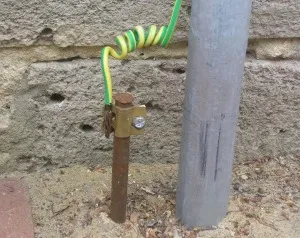
Electrical earthing is the process of transferring the immediate discharge of electrical energy to the earth through a low resistance wire.
It is done by connecting the neutral points of an electrical system, such as the earth terminals of socket cables to the earth plate, usually buried in the ground.
Grounding helps prevent electrocution whenever there is an electrical discharge. It also protects our building from lightning.
Importance of earthing installation
Earthing plays an important role in electrical safety, they include:
- Offers lightning protection
- Protection against electrical overload and short circuits
- Helps direct high voltage or faulty currents
- Stabilize voltage level
- Prevents electric shock.
Types of electrical earthing
There are two types of electrical earthing system
- Equipment Earthing
- Neutral earthing.
Equipment Earthing
This is the type of earthing done on electrical equipment. The non-current carrying part of the equipment is usually connected directly to the earth using a conducting wire.
Anytime there is a short circuit or fault current, it follows the path to the ground protecting the system and equipment from damage.
Neutral earthing
Neutral earthing is the earthing method used on electrical appliances that have star winding. Such devices include transformers, generators, motors, and so forth.
The neutrals of these systems are usually connected to the earth using a GI wire.
Components of an Earthing system
A good earthing system comprises:
- Earth cable
- Earthing Lead
- Earth plate or electrode
Earth cable
This is the wire that connects all the metallic parts of an electrical system such as the distribution boxes, plug sockets, fuse, and metallic shells.
The cable must be of low resistance, as per IEEE law, which states that the resistance between the consumer earth terminal and the earth continuity conductor must be less than one (1) ohms.
Earthing lead or joint
This is the copper wire or conductor that connects the earth cable and the electrode. The point at which the earth cable joins with the earthing lead is the connecting point.
The earthing lead must be straight, lower in size, and must have a few joints.
Although we often use copper wires as earthing lead, copper strips are preferable for high installations as they carry a higher amount of faulty currents because of their wider area.
We may also use hard drawn bare copper wire as an earthing joint. In such a case, we connect all the earth conductors to one connecting point, before using the earthing joint to connect it to the electrode (earth plate).
To increase the protection of electrical installations, we use two copper wires as an earthing joint to connect the device’s metal body to the earth plate.
When there are two earth plates, the earthing lead, or joint should be four, to improve their carrying capacity.
Earth plate or electrode.
This is a metallic plate usually buried inside the ground. It is the last part of an electrical grounding system. A good electrode must have a low resistance to carry the faulty current to the ground.
Method of electrical grounding
Below are the steps to a good electrical earthing
- Dig a pit of about 1.5 by 1.5m in the ground. Note that the depth and width of the pit will depend on the ground.
- Bury a copper plate of about 600 x 600 x300m vertically in the pit.
- Tighten the earth’s lead with bolts from the earth plate.
- Use two earth leads to tightening each plate.
- Rub grease on the earth’s joints to prevent corrosion.
- Connect all the wires to the metallic pipe from the earth electrode. Also, be sure that the pipe is at least one foot above the Earth’s surface.
- Use about a 1-foot layer of powdered charcoal, mixed with lime around the earth plate to maintain the soil mixture.
- Make sure that the earth cable which is connected to the metallic parts of all installations is tightly connected to the earth lead.
- Using your earth tester, test the Earthing system to make sure it is working fine before filling the pit. Note, the earthing resistance should not be more than 1Ω. If it is above 1ohm, increase the size (not the length) of the earth cable and lead. Keep the external ends of the pipe open to water it often, to maintain the moisture condition around the earth electrode, which is necessary for a better earthing system.